Lucian of Samosata was a second-century author writing in Roman Turkey. He’s best-known in modern geek circles for his novel A True History, which some hold out as the earliest known work of science fiction. Last week we looked at some fantastical islands from this very silly story, but this week we’re going to dive into the science fiction elements: Lucian’s account of his adventures in outer space. He claims, tongue firmly in cheek, to have visited the Moon and Venus, to have participated in great space battles, and to have met all kinds of weird fantasy-type aliens. With a new edition of Spelljammer getting released today, now feels like the perfect time to take a look at Lucian’s A True History and the ways we can use it as inspiration for our own science-fantasy RPG adventures!
This post is brought to you by beloved Patreon backer Colin Wixted. Thanks for helping keep the lights on! If you want to help keep this blog going alongside Colin, head over to the Patreon page – and thank you!
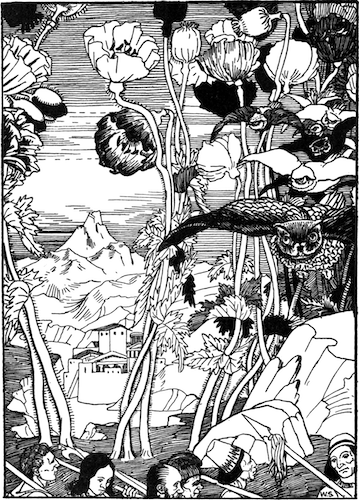
Lucian, his fifty Greek companions, and their ship got caught in a whirlwind and pulled into the sky. After seven days and nights, they landed on the Moon. They found the Moon was cultivated and settled, just like the Earth. The air was full of flying frogs. The sky was like the sky on Earth, except at night. When it was dark, Lucian could see other round islands like the Moon. They were of varying size, but all the color of fire. The one exception was the Earth, which hung overhead. You could see on it the cities and seas and rivers and mountains.
Lucian and his friends were confronted by the Hippogypians: the people of the Moon. Hippogpypians look like humans, except they are mostly hairless, save for the beards they sport on their knees. The rich wear garments of glass, the poor of bronze. Instead of horses, they ride vultures so large that each feather is longer than the mast of a tall ship. All Hippogpyians are male. There are many other differences between Earthlings and Hippogypians (including reproductive habits), but they’re not immediately apparent and we’ll talk about them later in the post.
A band of Hippogypian outriders seized Lucian and his friends and delivered them to the king. This was a spot of good luck, for the king was himself Greek! King Endymion came to the Moon by falling asleep on Earth and waking up here. The Hippogypians liked him so much they put him in charge. Endymion was overjoyed to see men of his former country – not least because Lucian and his party were heavily armed. Endymion had stumbled into war with Phaethon, the king of the Sun, and he could use reinforcements.
The reason for the war was a colony the people of the Moon sought to establish on the Morning Star. We would call this Venus. Educated Romans understood that the bright planet they saw around sunrise and the one they saw around sunset were the same body, but the linguistic and religious distinction between the Morning Star and the Evening Star was sticky. This colony, in the traditional Greek sense, would gather up a great deal of the landless and the urban poor and send them to the uninhabited Morning Star. There, they’d get a fresh start. They wouldn’t be subservient to the Moon (though they’d probably maintain close cultural ties), and would develop on their own. But King Phaethon of the Sun was jealous of this colony and sent his troops to attack the colonists while they were still crossing over from the Moon. The colonists were caught by surprise and forced to retreat. Now King Endymion was readying a counter-attack. Lucian and his companions agreed to participate in this battle and were given giant vultures to ride.
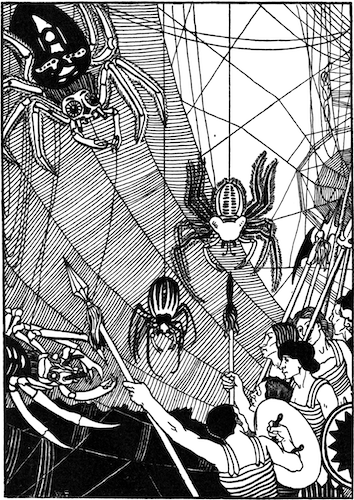
To reach the Morning Star, the army of the Moon marched along a web spun by enormous spiders. Each spider was bigger than an island in the Aegean Sea. In an instant, they spun a web in the air between the Moon and the Morning Star. Since soldiers could stand upon it, this web would also be the battlefield.
Lucian devotes considerable ink to describing the forces of the Moon-people and their allies. There were eighty thousand Hippogypians. Twenty thousand of them were mounted not on vultures but on Lachanopters: giant chickens with wort leaves instead of body feathers and lettuce leaves instead of wing feathers. Sixty thousand Psyllotoxotans and fifty thousand Anemodromians came from the constellation Ursa Major. Psyllotoxotans ride giant fleas the size of a dozen elephants. The Anemodromians fight on foot, yet wear long capes that they can use as sails in order to fly. There were also Cenchrobolians and Scorodomachians, but they don’t get descriptions.
The army of the Sun was no less fantastical. There were fifty thousand Hippomyrmicks, the inhabitants of the Sun. They are huge, winged, horned ants, the biggest of whom are two acres in size. (Or maybe they ride the huge ants? The translation I have is a little ambiguous). The Hippomyrmicks too had allies. There were fifty thousand Aeroconopes, archers mounted on giant gnats. There were the Aerocardakes, who cast from their slings not stones but poisonous turnips. Anyone struck by one developed a wound so stinky it killed them. There were fifty thousand Caulomycetes with mushroom shields and asparagus spears. And there were Cynobalanians from the dog-star Sirius who were men with the faces of dogs, riding on winged acorns.
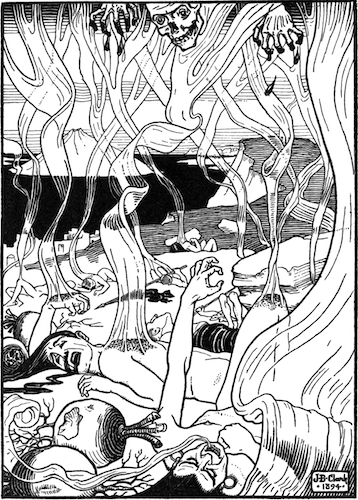
There were two battles. In the first, the fighting was so terrible that Lucian was sure the blood rained down upon the Earth. Ultimately the army of the Moon routed the army of the Sun. Then reinforcements showed up for the Sun: Nephelocentaurs. These creatures were from the waist up a man the size of the Colossus of Rhodes. From the waist down they were a winged horse as great as a cargo ship. Riding with them was their leader, the constellation Sagittarius. The Nephelocentaurs fell upon the army of the Moon. The fleeing army of the Sun took heart and returned. The Moon-soldiers retreated into their walled city, and the Sun-soldiers conquered the entire spiderweb.
Instead of besieging the Moon-city, the Sun-army opted to blockade it with an eclipse. They built a double wall of clouds in the air between the Sun and the Moon to keep the Moon in eternal night. This was so awful that Endymion agreed to a peace treaty. The Moon would provide money and hostages to the Sun. In exchange, they would come to each other’s aid in war and they would found a colony on the Morning Star together.

Lucian and his companions stayed for some time on the Moon with Endymion, and he writes in detail about Lunar customs. Their vines grow not grapes but hailstones. When the wind shakes the vines, the hailstones fall towards our world, which is where hail storms come from. They keep a great pit covered in glass. On the glass you can see events on Earth, and in the pit you can hear them. Lucian reports he kept tabs on his Earthling friends this way, though they had no way to know they were being observed.
The Hippogpyians have many biological differences from Earth-people. Their insides are open. They have no organs inside them, just hair. They tuck objects inside their abdomens and use them as satchels. When their kids are cold, they climb up into their parents’ insides. Hippogpyians can remove their eyes and swap them amongst one another. In this way, rich men have many eyes to choose from. When Hippogpyians die, they fade away like smoke and disappear.
You may remember that there are no women on the moon. Men marry men. They have a hole in their leg that they use for sex. Babies develop in the leg. When the leg grows swollen, they lance it and take out a dead baby, which eventually comes to life. There are also Moon-men called Dendritans, which extract each others’ right testicle and plant it in the ground like an acorn. From it grows a tree with a trunk of flesh that grows big fruits. Inside the fruits are little men that grow up to be full-sized Dendritans. The Dendritans’ dicks are artificial and come on and off as the wearer pleases. Rich men have dicks made of ivory, poor men of wood.
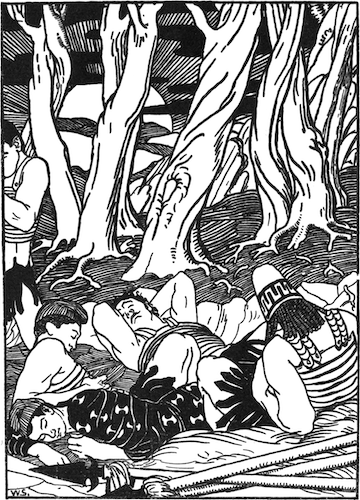
Using Dendritans and Hippogypians at the gaming table risks being fraught. We’re in the midst of a great shift in gender and sexual norms, and a few elements touched on in Lucian’s silly story are currently incredibly important. As always, the solution is simple: know your players. Know what they enjoy. Know what they find interesting, fun, and engaging. Know too what they don’t want to see. If you’re not sure, just ask ‘em. It doesn’t have to be some big to-do, just “Hey, I’m thinking of doing this thing next session. Would y’all find that fun or nah?”
But I also think Lucian offers us some really interesting context for the great shift we’re currently experiencing. Lucian came from a world whose gender and sexual norms are fairly foreign to us: a world where state-recognized concubinage was common among the rich and where the theater was inextricably linked with sex work, just to give two examples. In his silly story, Lucian seeks to present gender and sexual norms that are foreign to his audience – an audience that’s already foreign to us. The result is so nonsensical it’s almost like Mad Libs. For example, the Hippogypians “are given in marriage to others” until age 25, after which they “take others in marriage to themselves”. I can think of some possibilities for what that might mean (the Victorian translation I used does us no favors), but it’s still a distinction so weird that I struggle to imagine a modern author conceiving of it. Lucian’s silly story provides a wonderful reminder of the facts that sex is weird, gender is weird, and perceptions of both change constantly across time and distance.
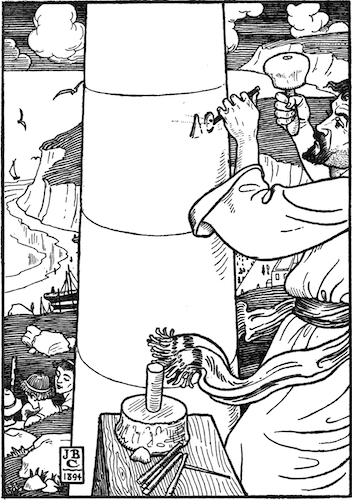
Let’s say you’ve got an ongoing fantasy campaign. You want to get the PCs into an outer space war adventure (perhaps some sort of Star War?). How do you get your party into space? Lucian gives us three easy possibilities. The party might get picked up by a whirlwind and deposited on some other world. The party might fall asleep on Earth and wake up elsewhere. Or the PCs might see a web being made by enormous tame spiders that stretches between the party’s world and some other. Traveling up the web brings them to the Moon, the Sun, or another cool place.
Then what do the PCs do once they’re there? If you want to do some big Star War, I’d encourage you to draw from my PCs on the Battlefield series, which focuses on interesting battles where individual people (like the PCs) could have an outsize impact on the outcome. Or maybe your players just want to exist in this strange setting and soak up the weirdness. It’s not my jam, but I’ve definitely gamed with people who love that exist-and-soak style of play. Finally, maybe you want to use this as a launching-off point for weird explorations among the stars. If so, last week’s post on bizarre islands in Lucian’s A True History is a great jumping-off point. So too is most anything in my back catalog in the ‘Travel’ category.






